Analyzing the Impact of Online Marketing on Sports Retail in India
VerifiedAdded on 2022/12/20
|123
|24901
|2
Project
AI Summary
This MBA project examines the impact of online marketing on the retail sports industry in India, focusing on consumer behavior and e-commerce trends. The research investigates the influence of digital marketing on purchasing decisions, particularly for major brands like Adidas, Reebok, and Nike. Utilizing a positivism approach and a descriptive research design, the study employs both primary data collection through surveys and interviews with 150 customers, and secondary data analysis of existing literature. The project applies models like McKinsey’s Consumer Decision Process and Kurt Lewin’s Three-Step Change Model to understand the shift from offline to online retail. The findings highlight the increasing preference for online shopping and the need for companies to adapt, potentially by incorporating innovations such as drone delivery. The research aims to understand the decision-making process of customers in the e-retailing environment, emphasizing the importance of social media marketing practices.
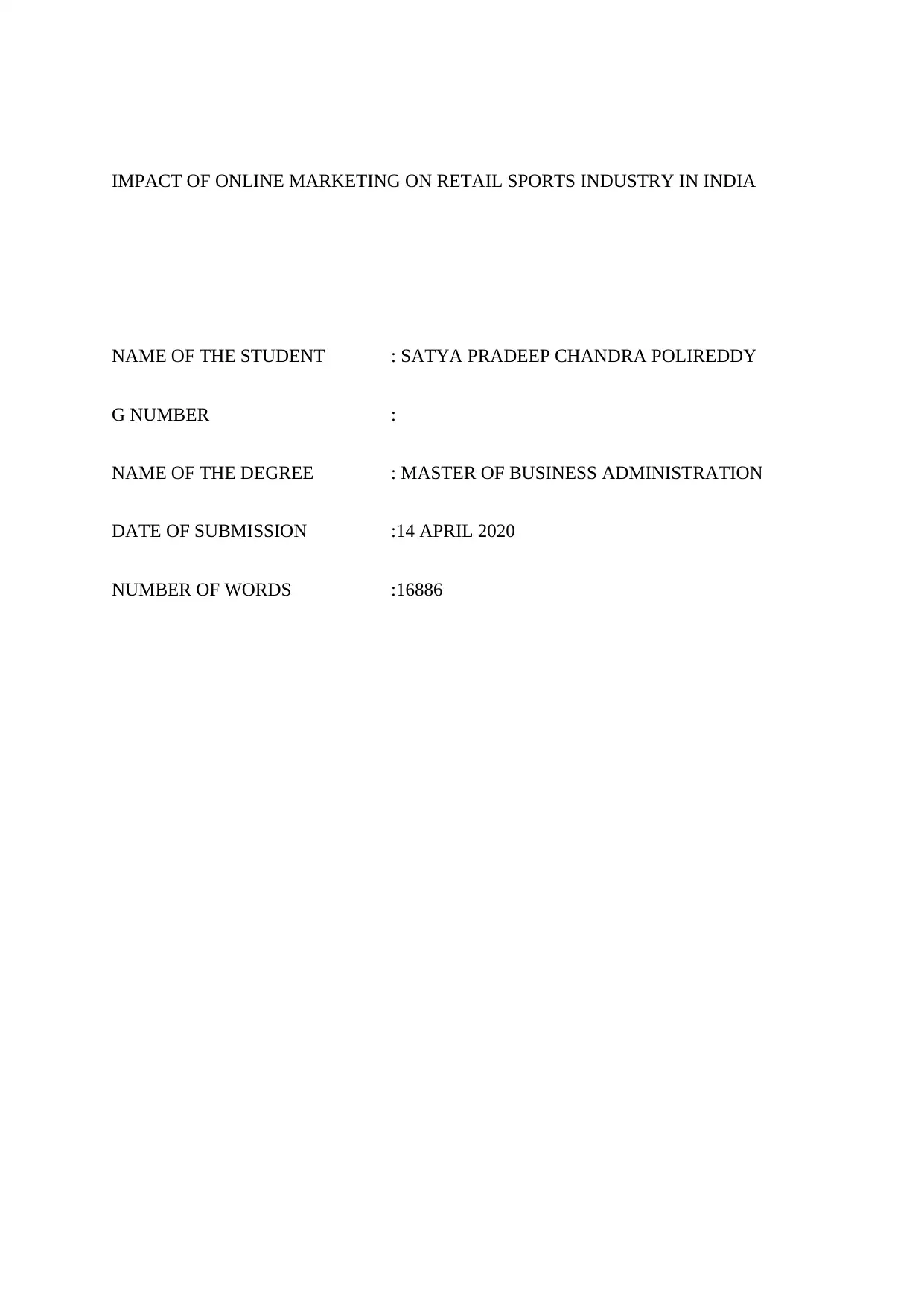
IMPACT OF ONLINE MARKETING ON RETAIL SPORTS INDUSTRY IN INDIA
NAME OF THE STUDENT : SATYA PRADEEP CHANDRA POLIREDDY
G NUMBER :
NAME OF THE DEGREE : MASTER OF BUSINESS ADMINISTRATION
DATE OF SUBMISSION :14 APRIL 2020
NUMBER OF WORDS :16886
NAME OF THE STUDENT : SATYA PRADEEP CHANDRA POLIREDDY
G NUMBER :
NAME OF THE DEGREE : MASTER OF BUSINESS ADMINISTRATION
DATE OF SUBMISSION :14 APRIL 2020
NUMBER OF WORDS :16886
Paraphrase This Document
Need a fresh take? Get an instant paraphrase of this document with our AI Paraphraser
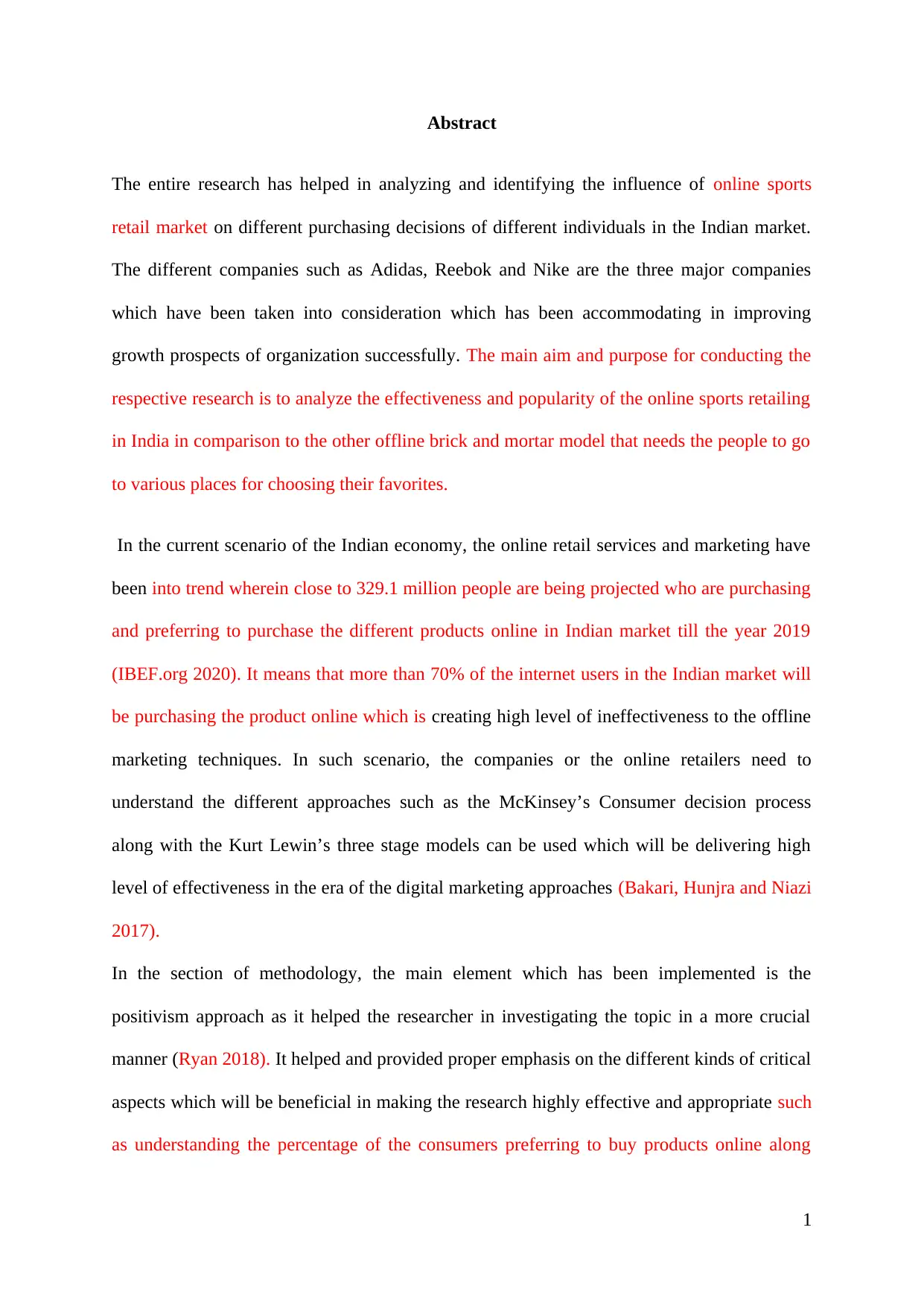
Abstract
The entire research has helped in analyzing and identifying the influence of online sports
retail market on different purchasing decisions of different individuals in the Indian market.
The different companies such as Adidas, Reebok and Nike are the three major companies
which have been taken into consideration which has been accommodating in improving
growth prospects of organization successfully. The main aim and purpose for conducting the
respective research is to analyze the effectiveness and popularity of the online sports retailing
in India in comparison to the other offline brick and mortar model that needs the people to go
to various places for choosing their favorites.
In the current scenario of the Indian economy, the online retail services and marketing have
been into trend wherein close to 329.1 million people are being projected who are purchasing
and preferring to purchase the different products online in Indian market till the year 2019
(IBEF.org 2020). It means that more than 70% of the internet users in the Indian market will
be purchasing the product online which is creating high level of ineffectiveness to the offline
marketing techniques. In such scenario, the companies or the online retailers need to
understand the different approaches such as the McKinsey’s Consumer decision process
along with the Kurt Lewin’s three stage models can be used which will be delivering high
level of effectiveness in the era of the digital marketing approaches (Bakari, Hunjra and Niazi
2017).
In the section of methodology, the main element which has been implemented is the
positivism approach as it helped the researcher in investigating the topic in a more crucial
manner (Ryan 2018). It helped and provided proper emphasis on the different kinds of critical
aspects which will be beneficial in making the research highly effective and appropriate such
as understanding the percentage of the consumers preferring to buy products online along
1
The entire research has helped in analyzing and identifying the influence of online sports
retail market on different purchasing decisions of different individuals in the Indian market.
The different companies such as Adidas, Reebok and Nike are the three major companies
which have been taken into consideration which has been accommodating in improving
growth prospects of organization successfully. The main aim and purpose for conducting the
respective research is to analyze the effectiveness and popularity of the online sports retailing
in India in comparison to the other offline brick and mortar model that needs the people to go
to various places for choosing their favorites.
In the current scenario of the Indian economy, the online retail services and marketing have
been into trend wherein close to 329.1 million people are being projected who are purchasing
and preferring to purchase the different products online in Indian market till the year 2019
(IBEF.org 2020). It means that more than 70% of the internet users in the Indian market will
be purchasing the product online which is creating high level of ineffectiveness to the offline
marketing techniques. In such scenario, the companies or the online retailers need to
understand the different approaches such as the McKinsey’s Consumer decision process
along with the Kurt Lewin’s three stage models can be used which will be delivering high
level of effectiveness in the era of the digital marketing approaches (Bakari, Hunjra and Niazi
2017).
In the section of methodology, the main element which has been implemented is the
positivism approach as it helped the researcher in investigating the topic in a more crucial
manner (Ryan 2018). It helped and provided proper emphasis on the different kinds of critical
aspects which will be beneficial in making the research highly effective and appropriate such
as understanding the percentage of the consumers preferring to buy products online along
1
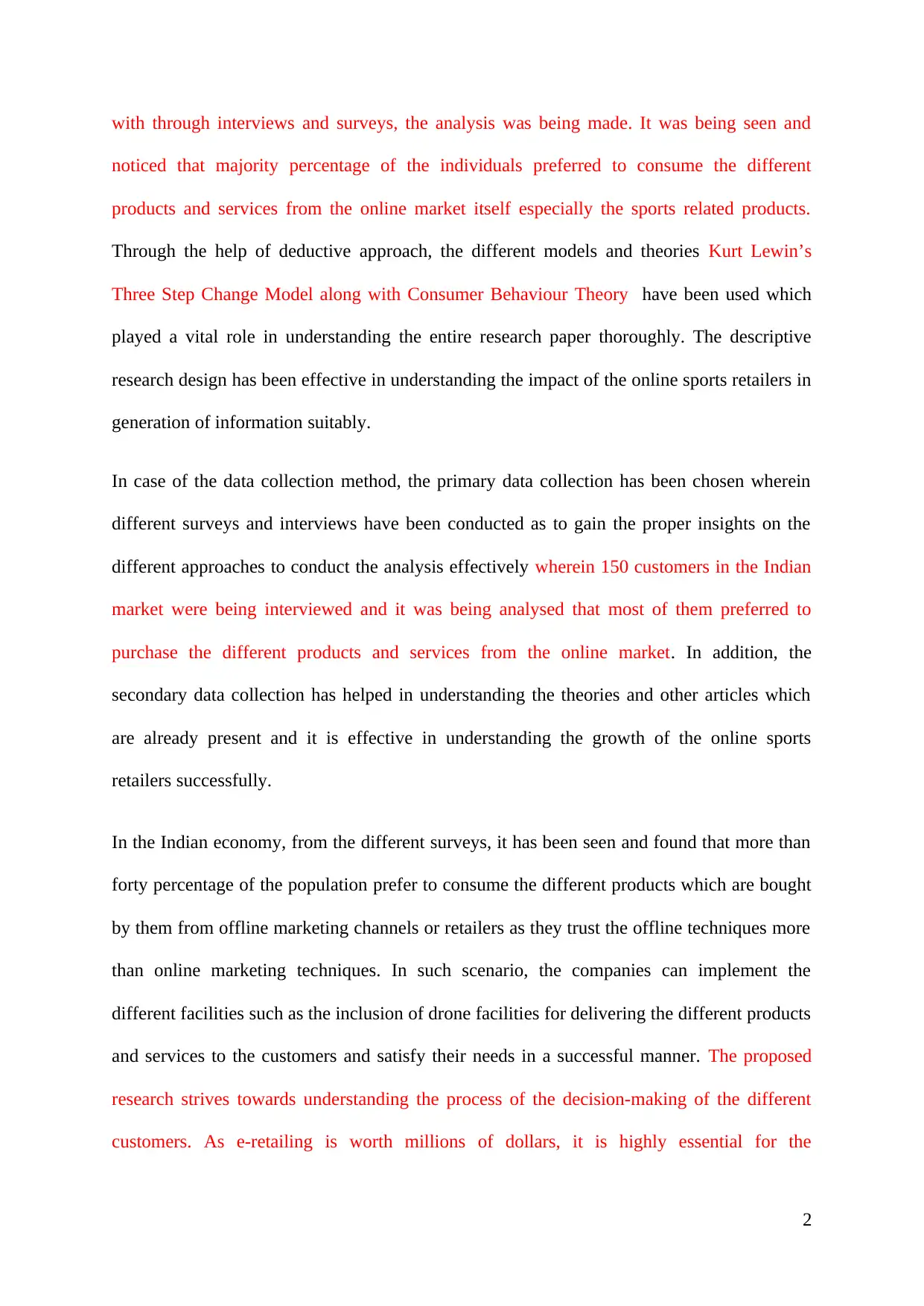
with through interviews and surveys, the analysis was being made. It was being seen and
noticed that majority percentage of the individuals preferred to consume the different
products and services from the online market itself especially the sports related products.
Through the help of deductive approach, the different models and theories Kurt Lewin’s
Three Step Change Model along with Consumer Behaviour Theory have been used which
played a vital role in understanding the entire research paper thoroughly. The descriptive
research design has been effective in understanding the impact of the online sports retailers in
generation of information suitably.
In case of the data collection method, the primary data collection has been chosen wherein
different surveys and interviews have been conducted as to gain the proper insights on the
different approaches to conduct the analysis effectively wherein 150 customers in the Indian
market were being interviewed and it was being analysed that most of them preferred to
purchase the different products and services from the online market. In addition, the
secondary data collection has helped in understanding the theories and other articles which
are already present and it is effective in understanding the growth of the online sports
retailers successfully.
In the Indian economy, from the different surveys, it has been seen and found that more than
forty percentage of the population prefer to consume the different products which are bought
by them from offline marketing channels or retailers as they trust the offline techniques more
than online marketing techniques. In such scenario, the companies can implement the
different facilities such as the inclusion of drone facilities for delivering the different products
and services to the customers and satisfy their needs in a successful manner. The proposed
research strives towards understanding the process of the decision-making of the different
customers. As e-retailing is worth millions of dollars, it is highly essential for the
2
noticed that majority percentage of the individuals preferred to consume the different
products and services from the online market itself especially the sports related products.
Through the help of deductive approach, the different models and theories Kurt Lewin’s
Three Step Change Model along with Consumer Behaviour Theory have been used which
played a vital role in understanding the entire research paper thoroughly. The descriptive
research design has been effective in understanding the impact of the online sports retailers in
generation of information suitably.
In case of the data collection method, the primary data collection has been chosen wherein
different surveys and interviews have been conducted as to gain the proper insights on the
different approaches to conduct the analysis effectively wherein 150 customers in the Indian
market were being interviewed and it was being analysed that most of them preferred to
purchase the different products and services from the online market. In addition, the
secondary data collection has helped in understanding the theories and other articles which
are already present and it is effective in understanding the growth of the online sports
retailers successfully.
In the Indian economy, from the different surveys, it has been seen and found that more than
forty percentage of the population prefer to consume the different products which are bought
by them from offline marketing channels or retailers as they trust the offline techniques more
than online marketing techniques. In such scenario, the companies can implement the
different facilities such as the inclusion of drone facilities for delivering the different products
and services to the customers and satisfy their needs in a successful manner. The proposed
research strives towards understanding the process of the decision-making of the different
customers. As e-retailing is worth millions of dollars, it is highly essential for the
2
⊘ This is a preview!⊘
Do you want full access?
Subscribe today to unlock all pages.

Trusted by 1+ million students worldwide
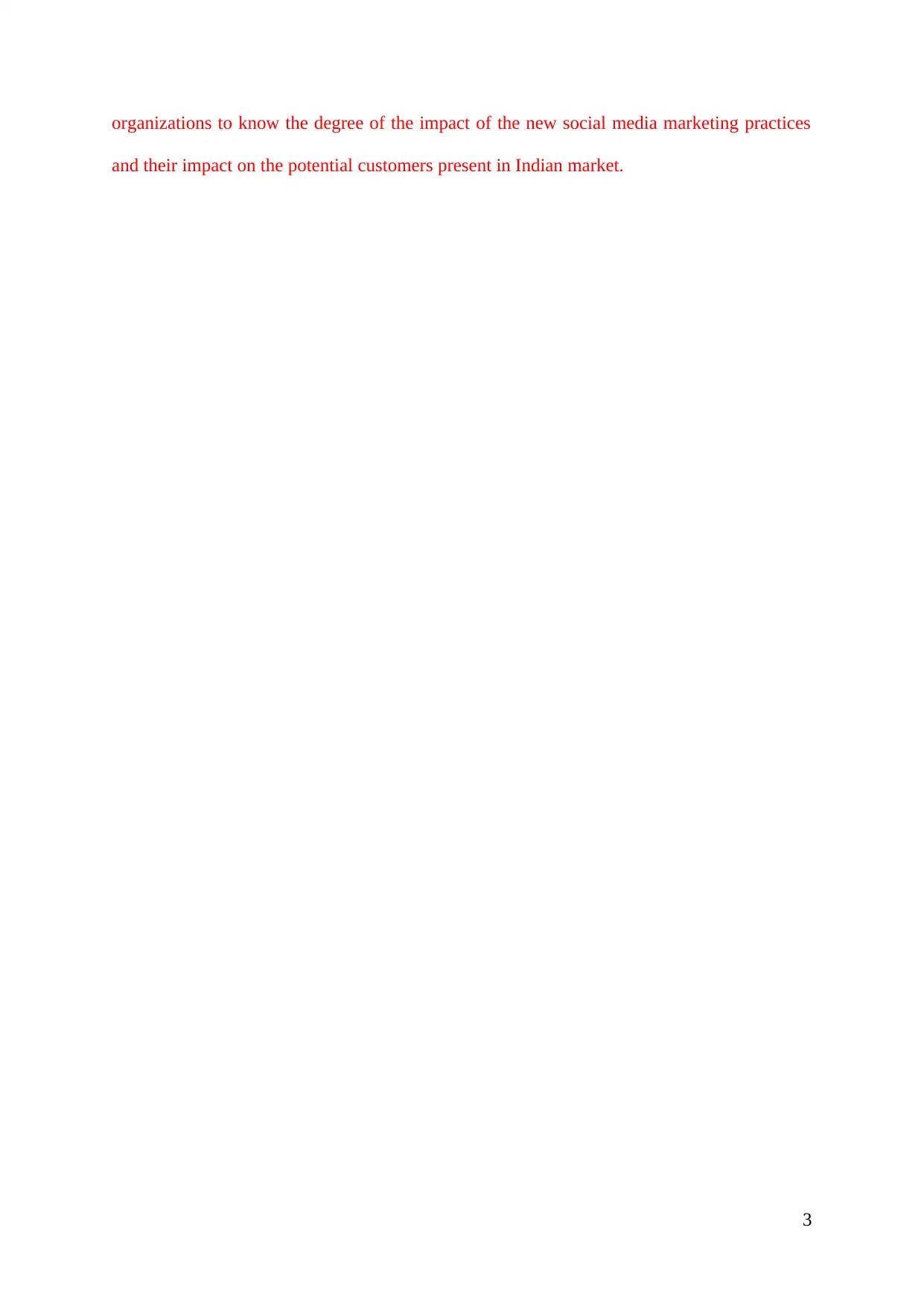
organizations to know the degree of the impact of the new social media marketing practices
and their impact on the potential customers present in Indian market.
3
and their impact on the potential customers present in Indian market.
3
Paraphrase This Document
Need a fresh take? Get an instant paraphrase of this document with our AI Paraphraser
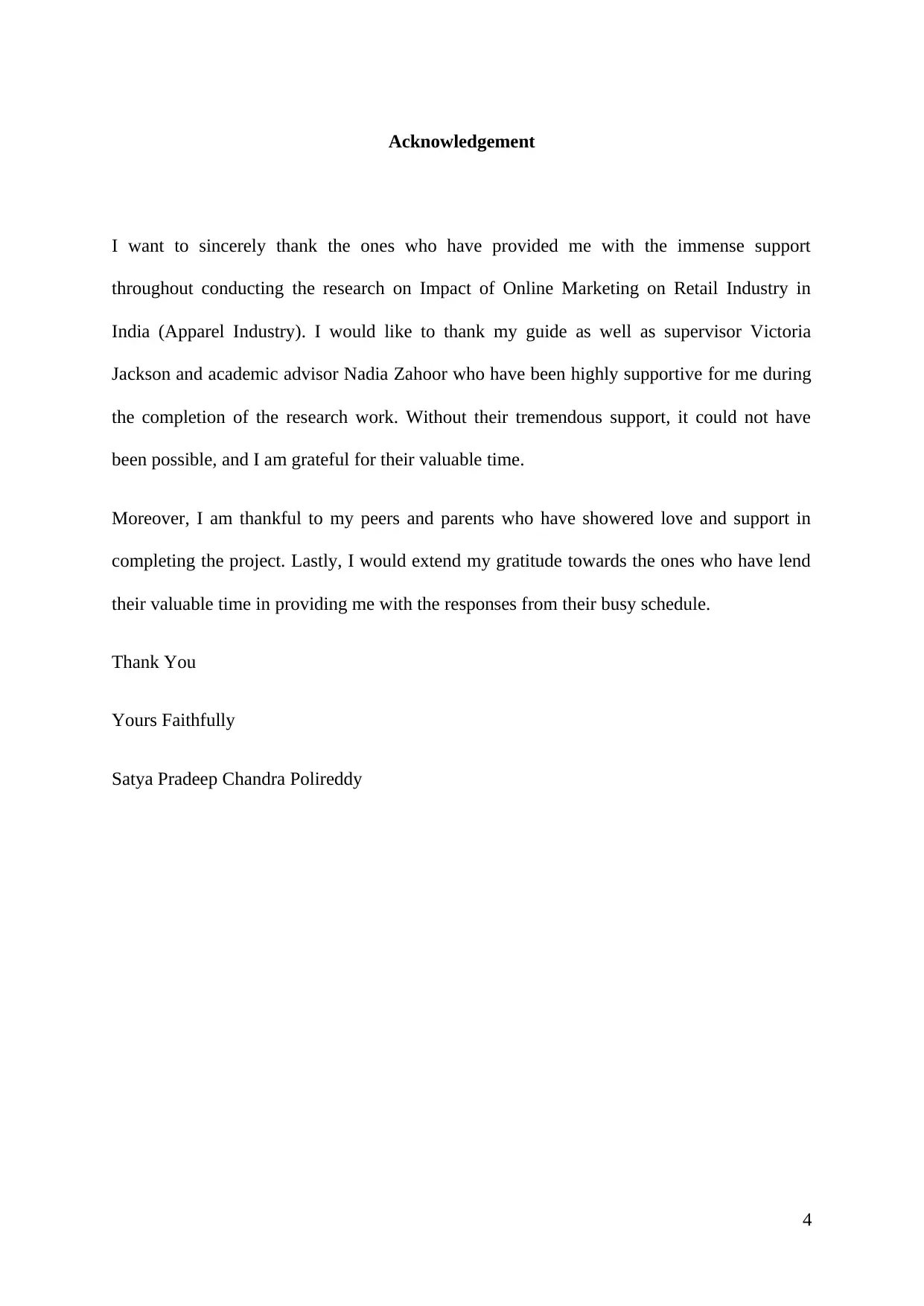
Acknowledgement
I want to sincerely thank the ones who have provided me with the immense support
throughout conducting the research on Impact of Online Marketing on Retail Industry in
India (Apparel Industry). I would like to thank my guide as well as supervisor Victoria
Jackson and academic advisor Nadia Zahoor who have been highly supportive for me during
the completion of the research work. Without their tremendous support, it could not have
been possible, and I am grateful for their valuable time.
Moreover, I am thankful to my peers and parents who have showered love and support in
completing the project. Lastly, I would extend my gratitude towards the ones who have lend
their valuable time in providing me with the responses from their busy schedule.
Thank You
Yours Faithfully
Satya Pradeep Chandra Polireddy
4
I want to sincerely thank the ones who have provided me with the immense support
throughout conducting the research on Impact of Online Marketing on Retail Industry in
India (Apparel Industry). I would like to thank my guide as well as supervisor Victoria
Jackson and academic advisor Nadia Zahoor who have been highly supportive for me during
the completion of the research work. Without their tremendous support, it could not have
been possible, and I am grateful for their valuable time.
Moreover, I am thankful to my peers and parents who have showered love and support in
completing the project. Lastly, I would extend my gratitude towards the ones who have lend
their valuable time in providing me with the responses from their busy schedule.
Thank You
Yours Faithfully
Satya Pradeep Chandra Polireddy
4
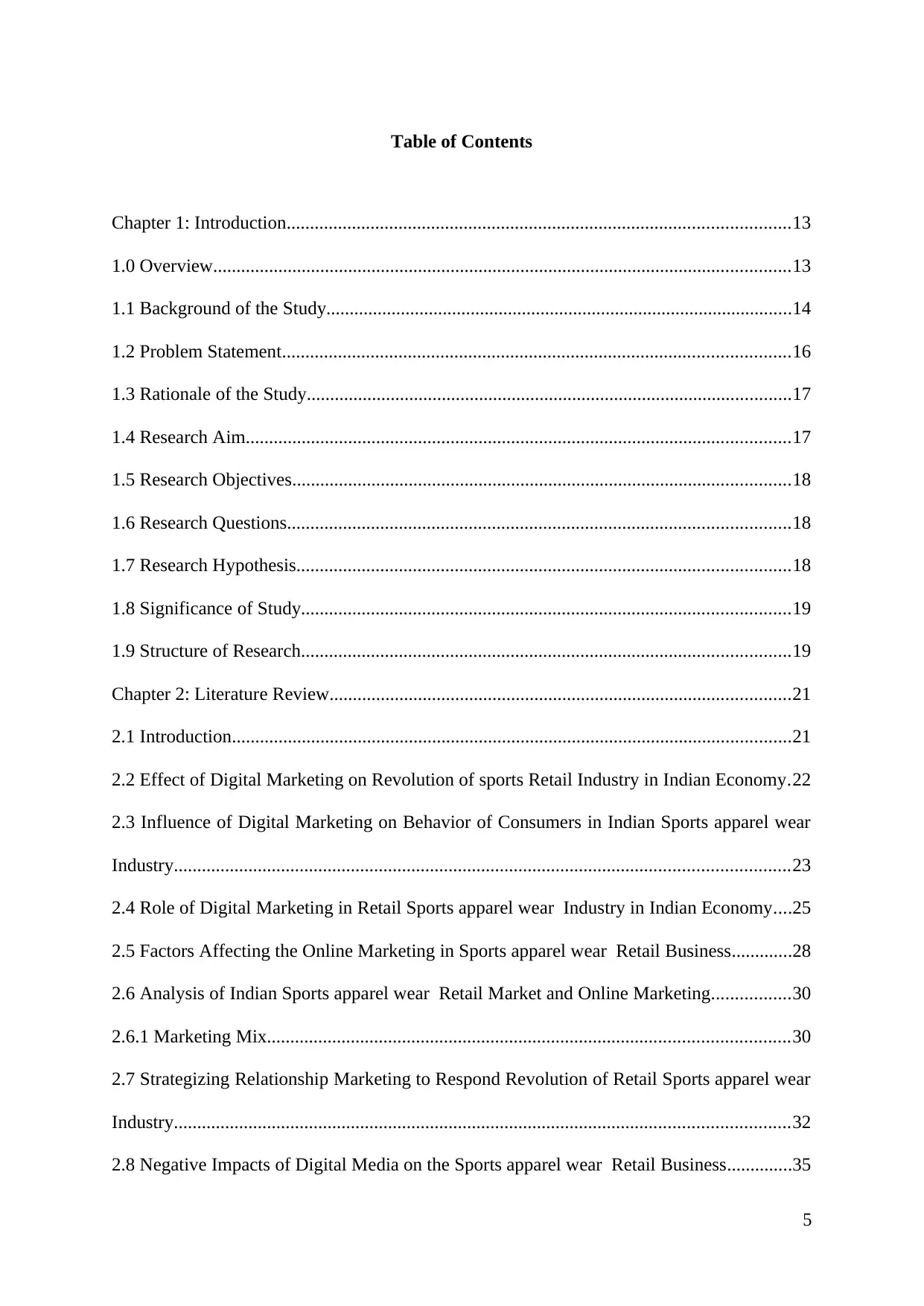
Table of Contents
Chapter 1: Introduction............................................................................................................13
1.0 Overview............................................................................................................................13
1.1 Background of the Study....................................................................................................14
1.2 Problem Statement.............................................................................................................16
1.3 Rationale of the Study........................................................................................................17
1.4 Research Aim.....................................................................................................................17
1.5 Research Objectives...........................................................................................................18
1.6 Research Questions............................................................................................................18
1.7 Research Hypothesis..........................................................................................................18
1.8 Significance of Study.........................................................................................................19
1.9 Structure of Research.........................................................................................................19
Chapter 2: Literature Review...................................................................................................21
2.1 Introduction........................................................................................................................21
2.2 Effect of Digital Marketing on Revolution of sports Retail Industry in Indian Economy.22
2.3 Influence of Digital Marketing on Behavior of Consumers in Indian Sports apparel wear
Industry....................................................................................................................................23
2.4 Role of Digital Marketing in Retail Sports apparel wear Industry in Indian Economy....25
2.5 Factors Affecting the Online Marketing in Sports apparel wear Retail Business.............28
2.6 Analysis of Indian Sports apparel wear Retail Market and Online Marketing.................30
2.6.1 Marketing Mix................................................................................................................30
2.7 Strategizing Relationship Marketing to Respond Revolution of Retail Sports apparel wear
Industry....................................................................................................................................32
2.8 Negative Impacts of Digital Media on the Sports apparel wear Retail Business..............35
5
Chapter 1: Introduction............................................................................................................13
1.0 Overview............................................................................................................................13
1.1 Background of the Study....................................................................................................14
1.2 Problem Statement.............................................................................................................16
1.3 Rationale of the Study........................................................................................................17
1.4 Research Aim.....................................................................................................................17
1.5 Research Objectives...........................................................................................................18
1.6 Research Questions............................................................................................................18
1.7 Research Hypothesis..........................................................................................................18
1.8 Significance of Study.........................................................................................................19
1.9 Structure of Research.........................................................................................................19
Chapter 2: Literature Review...................................................................................................21
2.1 Introduction........................................................................................................................21
2.2 Effect of Digital Marketing on Revolution of sports Retail Industry in Indian Economy.22
2.3 Influence of Digital Marketing on Behavior of Consumers in Indian Sports apparel wear
Industry....................................................................................................................................23
2.4 Role of Digital Marketing in Retail Sports apparel wear Industry in Indian Economy....25
2.5 Factors Affecting the Online Marketing in Sports apparel wear Retail Business.............28
2.6 Analysis of Indian Sports apparel wear Retail Market and Online Marketing.................30
2.6.1 Marketing Mix................................................................................................................30
2.7 Strategizing Relationship Marketing to Respond Revolution of Retail Sports apparel wear
Industry....................................................................................................................................32
2.8 Negative Impacts of Digital Media on the Sports apparel wear Retail Business..............35
5
⊘ This is a preview!⊘
Do you want full access?
Subscribe today to unlock all pages.

Trusted by 1+ million students worldwide
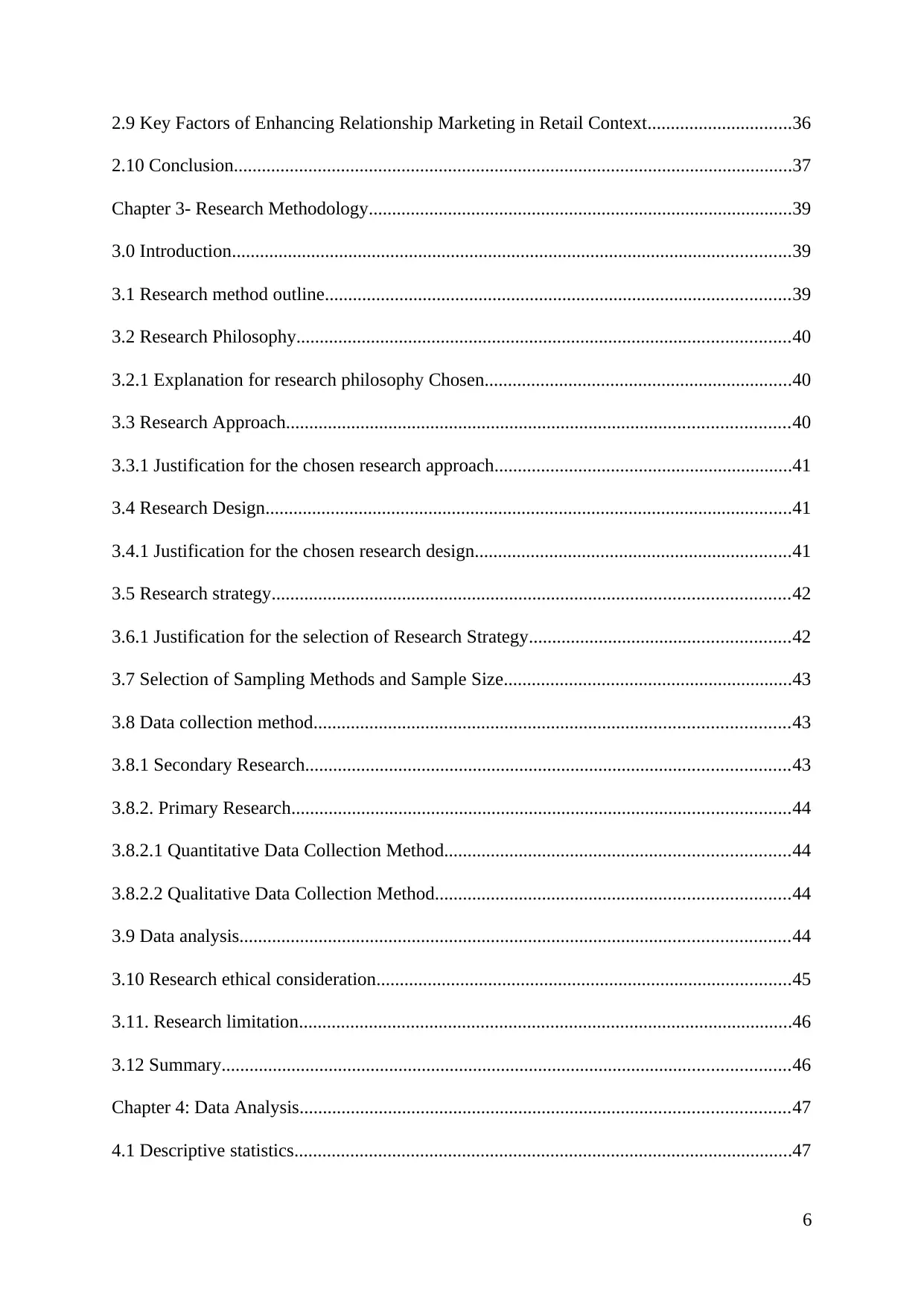
2.9 Key Factors of Enhancing Relationship Marketing in Retail Context...............................36
2.10 Conclusion........................................................................................................................37
Chapter 3- Research Methodology...........................................................................................39
3.0 Introduction........................................................................................................................39
3.1 Research method outline....................................................................................................39
3.2 Research Philosophy..........................................................................................................40
3.2.1 Explanation for research philosophy Chosen..................................................................40
3.3 Research Approach............................................................................................................40
3.3.1 Justification for the chosen research approach................................................................41
3.4 Research Design.................................................................................................................41
3.4.1 Justification for the chosen research design....................................................................41
3.5 Research strategy...............................................................................................................42
3.6.1 Justification for the selection of Research Strategy........................................................42
3.7 Selection of Sampling Methods and Sample Size..............................................................43
3.8 Data collection method......................................................................................................43
3.8.1 Secondary Research........................................................................................................43
3.8.2. Primary Research...........................................................................................................44
3.8.2.1 Quantitative Data Collection Method..........................................................................44
3.8.2.2 Qualitative Data Collection Method............................................................................44
3.9 Data analysis......................................................................................................................44
3.10 Research ethical consideration.........................................................................................45
3.11. Research limitation..........................................................................................................46
3.12 Summary..........................................................................................................................46
Chapter 4: Data Analysis.........................................................................................................47
4.1 Descriptive statistics...........................................................................................................47
6
2.10 Conclusion........................................................................................................................37
Chapter 3- Research Methodology...........................................................................................39
3.0 Introduction........................................................................................................................39
3.1 Research method outline....................................................................................................39
3.2 Research Philosophy..........................................................................................................40
3.2.1 Explanation for research philosophy Chosen..................................................................40
3.3 Research Approach............................................................................................................40
3.3.1 Justification for the chosen research approach................................................................41
3.4 Research Design.................................................................................................................41
3.4.1 Justification for the chosen research design....................................................................41
3.5 Research strategy...............................................................................................................42
3.6.1 Justification for the selection of Research Strategy........................................................42
3.7 Selection of Sampling Methods and Sample Size..............................................................43
3.8 Data collection method......................................................................................................43
3.8.1 Secondary Research........................................................................................................43
3.8.2. Primary Research...........................................................................................................44
3.8.2.1 Quantitative Data Collection Method..........................................................................44
3.8.2.2 Qualitative Data Collection Method............................................................................44
3.9 Data analysis......................................................................................................................44
3.10 Research ethical consideration.........................................................................................45
3.11. Research limitation..........................................................................................................46
3.12 Summary..........................................................................................................................46
Chapter 4: Data Analysis.........................................................................................................47
4.1 Descriptive statistics...........................................................................................................47
6
Paraphrase This Document
Need a fresh take? Get an instant paraphrase of this document with our AI Paraphraser
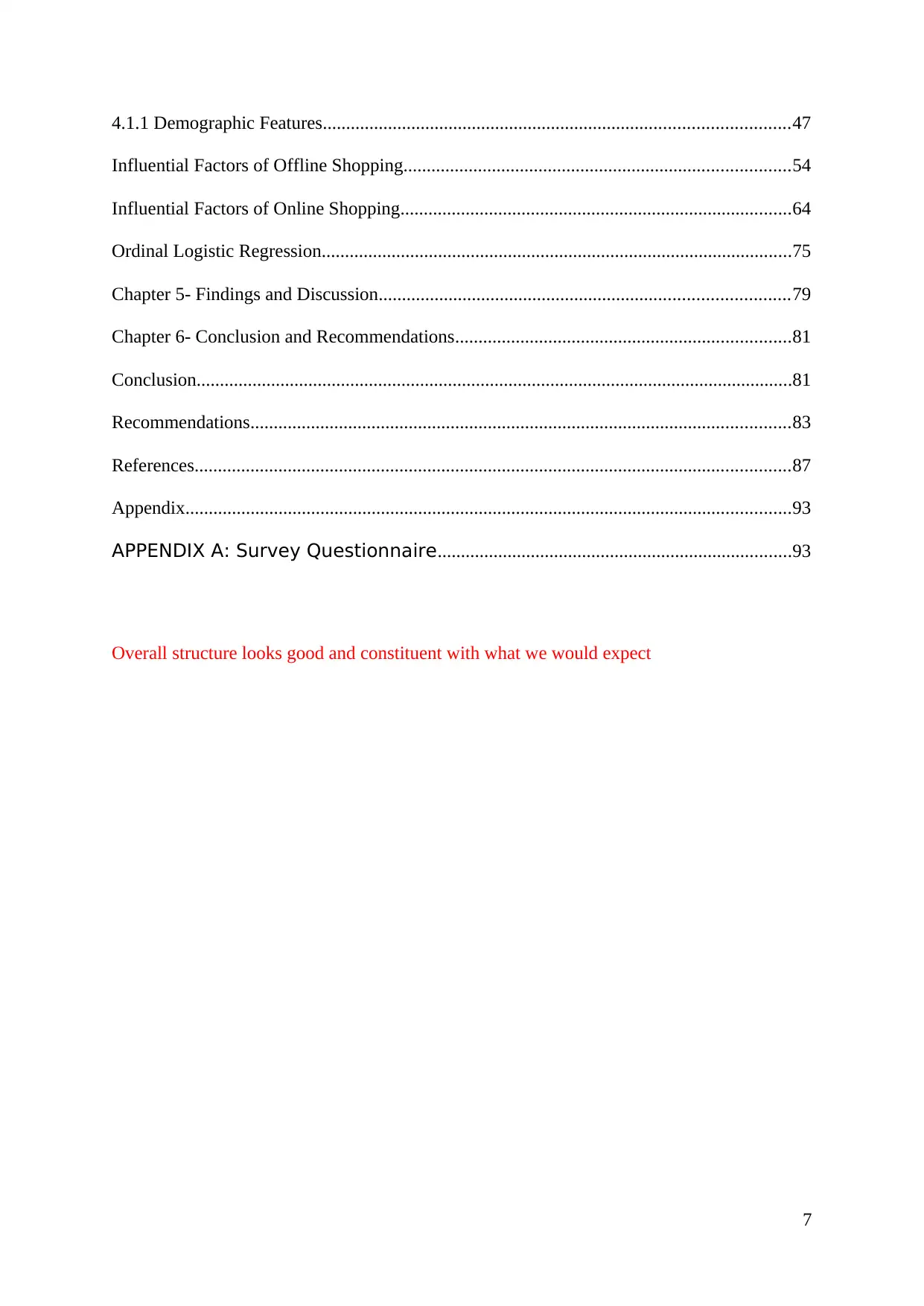
4.1.1 Demographic Features....................................................................................................47
Influential Factors of Offline Shopping...................................................................................54
Influential Factors of Online Shopping....................................................................................64
Ordinal Logistic Regression.....................................................................................................75
Chapter 5- Findings and Discussion........................................................................................79
Chapter 6- Conclusion and Recommendations........................................................................81
Conclusion................................................................................................................................81
Recommendations....................................................................................................................83
References................................................................................................................................87
Appendix..................................................................................................................................93
APPENDIX A: Survey Questionnaire............................................................................93
Overall structure looks good and constituent with what we would expect
7
Influential Factors of Offline Shopping...................................................................................54
Influential Factors of Online Shopping....................................................................................64
Ordinal Logistic Regression.....................................................................................................75
Chapter 5- Findings and Discussion........................................................................................79
Chapter 6- Conclusion and Recommendations........................................................................81
Conclusion................................................................................................................................81
Recommendations....................................................................................................................83
References................................................................................................................................87
Appendix..................................................................................................................................93
APPENDIX A: Survey Questionnaire............................................................................93
Overall structure looks good and constituent with what we would expect
7
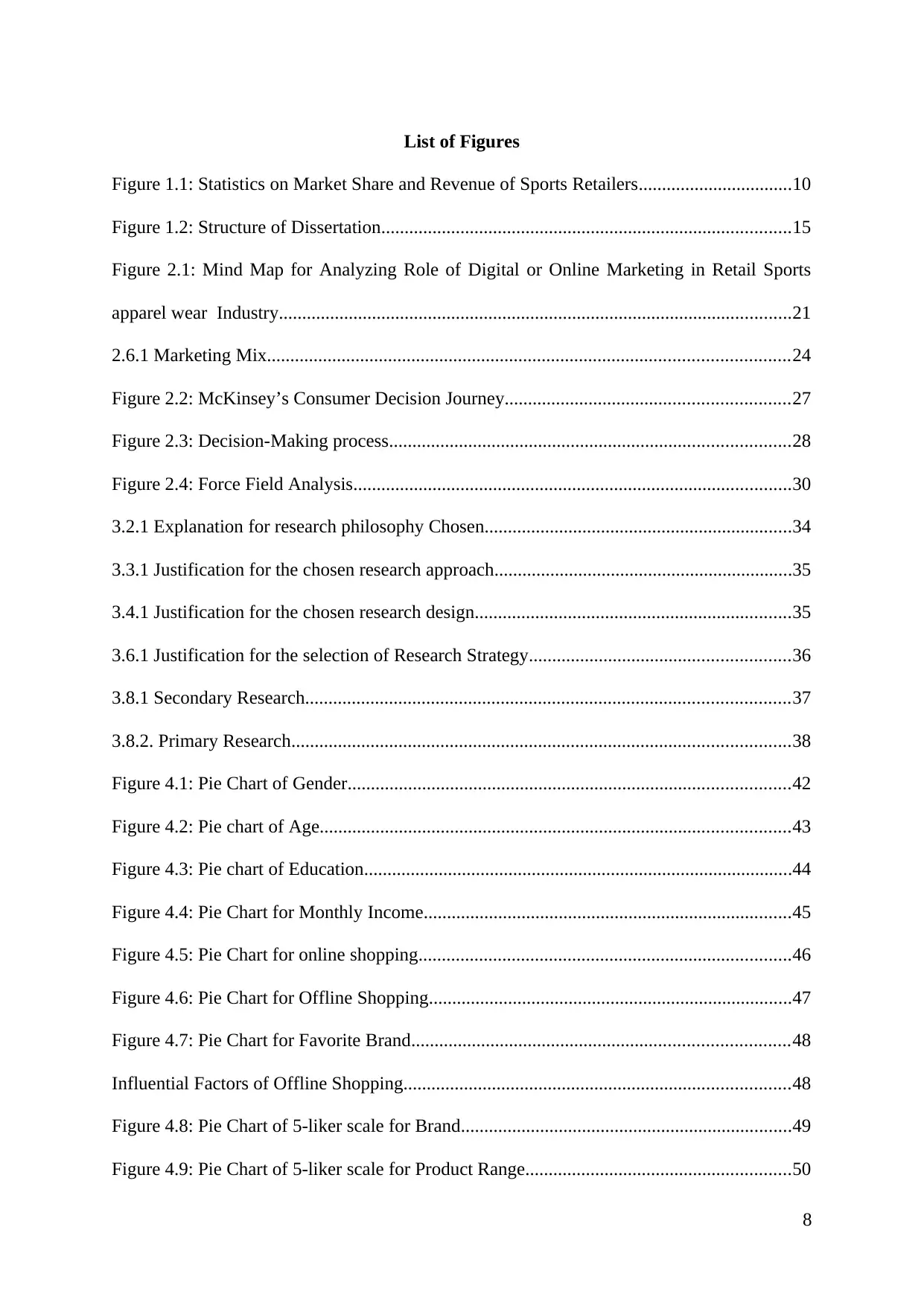
List of Figures
Figure 1.1: Statistics on Market Share and Revenue of Sports Retailers.................................10
Figure 1.2: Structure of Dissertation........................................................................................15
Figure 2.1: Mind Map for Analyzing Role of Digital or Online Marketing in Retail Sports
apparel wear Industry..............................................................................................................21
2.6.1 Marketing Mix................................................................................................................24
Figure 2.2: McKinsey’s Consumer Decision Journey.............................................................27
Figure 2.3: Decision-Making process......................................................................................28
Figure 2.4: Force Field Analysis..............................................................................................30
3.2.1 Explanation for research philosophy Chosen..................................................................34
3.3.1 Justification for the chosen research approach................................................................35
3.4.1 Justification for the chosen research design....................................................................35
3.6.1 Justification for the selection of Research Strategy........................................................36
3.8.1 Secondary Research........................................................................................................37
3.8.2. Primary Research...........................................................................................................38
Figure 4.1: Pie Chart of Gender...............................................................................................42
Figure 4.2: Pie chart of Age.....................................................................................................43
Figure 4.3: Pie chart of Education............................................................................................44
Figure 4.4: Pie Chart for Monthly Income...............................................................................45
Figure 4.5: Pie Chart for online shopping................................................................................46
Figure 4.6: Pie Chart for Offline Shopping..............................................................................47
Figure 4.7: Pie Chart for Favorite Brand.................................................................................48
Influential Factors of Offline Shopping...................................................................................48
Figure 4.8: Pie Chart of 5-liker scale for Brand.......................................................................49
Figure 4.9: Pie Chart of 5-liker scale for Product Range.........................................................50
8
Figure 1.1: Statistics on Market Share and Revenue of Sports Retailers.................................10
Figure 1.2: Structure of Dissertation........................................................................................15
Figure 2.1: Mind Map for Analyzing Role of Digital or Online Marketing in Retail Sports
apparel wear Industry..............................................................................................................21
2.6.1 Marketing Mix................................................................................................................24
Figure 2.2: McKinsey’s Consumer Decision Journey.............................................................27
Figure 2.3: Decision-Making process......................................................................................28
Figure 2.4: Force Field Analysis..............................................................................................30
3.2.1 Explanation for research philosophy Chosen..................................................................34
3.3.1 Justification for the chosen research approach................................................................35
3.4.1 Justification for the chosen research design....................................................................35
3.6.1 Justification for the selection of Research Strategy........................................................36
3.8.1 Secondary Research........................................................................................................37
3.8.2. Primary Research...........................................................................................................38
Figure 4.1: Pie Chart of Gender...............................................................................................42
Figure 4.2: Pie chart of Age.....................................................................................................43
Figure 4.3: Pie chart of Education............................................................................................44
Figure 4.4: Pie Chart for Monthly Income...............................................................................45
Figure 4.5: Pie Chart for online shopping................................................................................46
Figure 4.6: Pie Chart for Offline Shopping..............................................................................47
Figure 4.7: Pie Chart for Favorite Brand.................................................................................48
Influential Factors of Offline Shopping...................................................................................48
Figure 4.8: Pie Chart of 5-liker scale for Brand.......................................................................49
Figure 4.9: Pie Chart of 5-liker scale for Product Range.........................................................50
8
⊘ This is a preview!⊘
Do you want full access?
Subscribe today to unlock all pages.

Trusted by 1+ million students worldwide
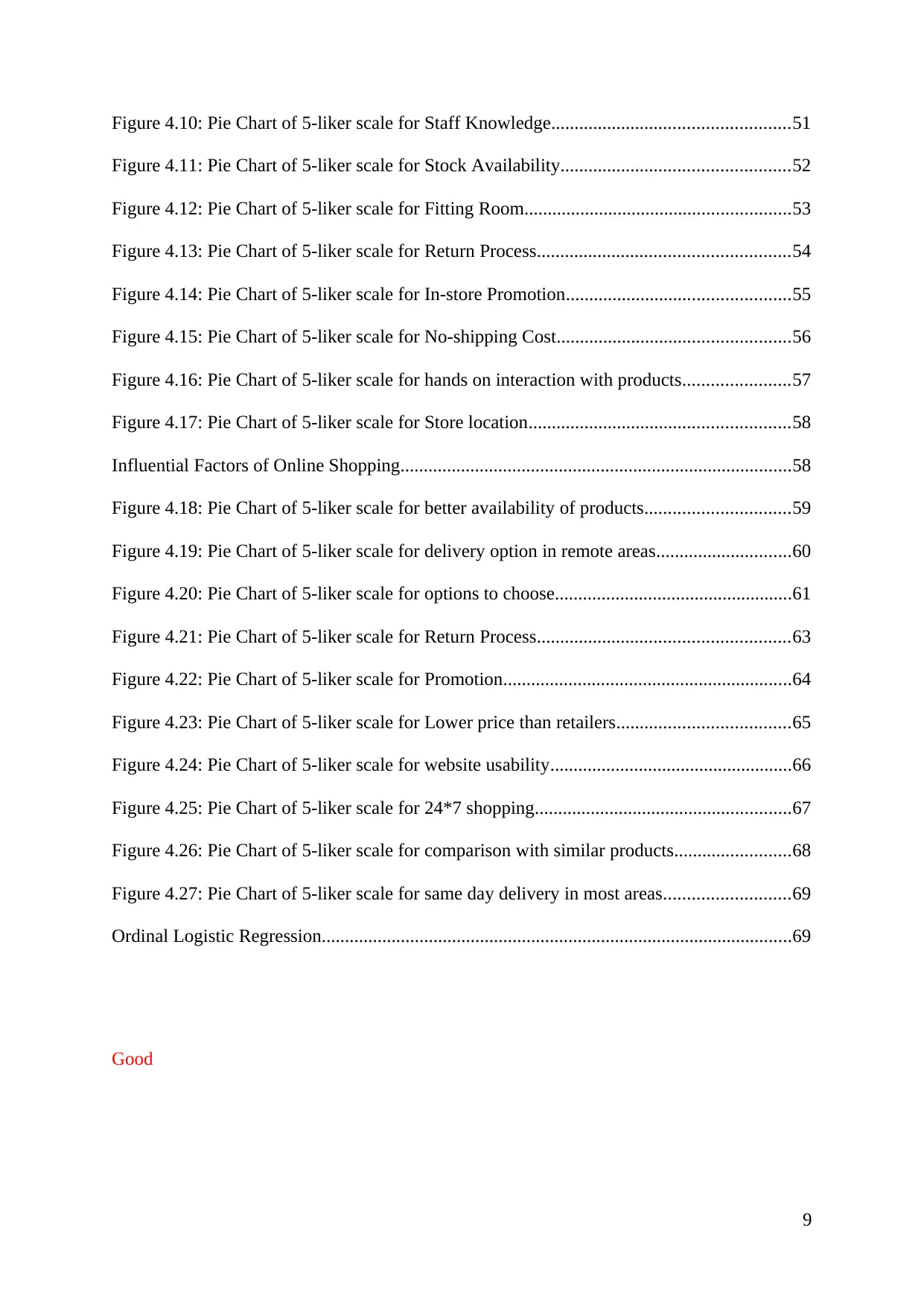
Figure 4.10: Pie Chart of 5-liker scale for Staff Knowledge...................................................51
Figure 4.11: Pie Chart of 5-liker scale for Stock Availability.................................................52
Figure 4.12: Pie Chart of 5-liker scale for Fitting Room.........................................................53
Figure 4.13: Pie Chart of 5-liker scale for Return Process......................................................54
Figure 4.14: Pie Chart of 5-liker scale for In-store Promotion................................................55
Figure 4.15: Pie Chart of 5-liker scale for No-shipping Cost..................................................56
Figure 4.16: Pie Chart of 5-liker scale for hands on interaction with products.......................57
Figure 4.17: Pie Chart of 5-liker scale for Store location........................................................58
Influential Factors of Online Shopping....................................................................................58
Figure 4.18: Pie Chart of 5-liker scale for better availability of products...............................59
Figure 4.19: Pie Chart of 5-liker scale for delivery option in remote areas.............................60
Figure 4.20: Pie Chart of 5-liker scale for options to choose...................................................61
Figure 4.21: Pie Chart of 5-liker scale for Return Process......................................................63
Figure 4.22: Pie Chart of 5-liker scale for Promotion..............................................................64
Figure 4.23: Pie Chart of 5-liker scale for Lower price than retailers.....................................65
Figure 4.24: Pie Chart of 5-liker scale for website usability....................................................66
Figure 4.25: Pie Chart of 5-liker scale for 24*7 shopping.......................................................67
Figure 4.26: Pie Chart of 5-liker scale for comparison with similar products.........................68
Figure 4.27: Pie Chart of 5-liker scale for same day delivery in most areas...........................69
Ordinal Logistic Regression.....................................................................................................69
Good
9
Figure 4.11: Pie Chart of 5-liker scale for Stock Availability.................................................52
Figure 4.12: Pie Chart of 5-liker scale for Fitting Room.........................................................53
Figure 4.13: Pie Chart of 5-liker scale for Return Process......................................................54
Figure 4.14: Pie Chart of 5-liker scale for In-store Promotion................................................55
Figure 4.15: Pie Chart of 5-liker scale for No-shipping Cost..................................................56
Figure 4.16: Pie Chart of 5-liker scale for hands on interaction with products.......................57
Figure 4.17: Pie Chart of 5-liker scale for Store location........................................................58
Influential Factors of Online Shopping....................................................................................58
Figure 4.18: Pie Chart of 5-liker scale for better availability of products...............................59
Figure 4.19: Pie Chart of 5-liker scale for delivery option in remote areas.............................60
Figure 4.20: Pie Chart of 5-liker scale for options to choose...................................................61
Figure 4.21: Pie Chart of 5-liker scale for Return Process......................................................63
Figure 4.22: Pie Chart of 5-liker scale for Promotion..............................................................64
Figure 4.23: Pie Chart of 5-liker scale for Lower price than retailers.....................................65
Figure 4.24: Pie Chart of 5-liker scale for website usability....................................................66
Figure 4.25: Pie Chart of 5-liker scale for 24*7 shopping.......................................................67
Figure 4.26: Pie Chart of 5-liker scale for comparison with similar products.........................68
Figure 4.27: Pie Chart of 5-liker scale for same day delivery in most areas...........................69
Ordinal Logistic Regression.....................................................................................................69
Good
9
Paraphrase This Document
Need a fresh take? Get an instant paraphrase of this document with our AI Paraphraser
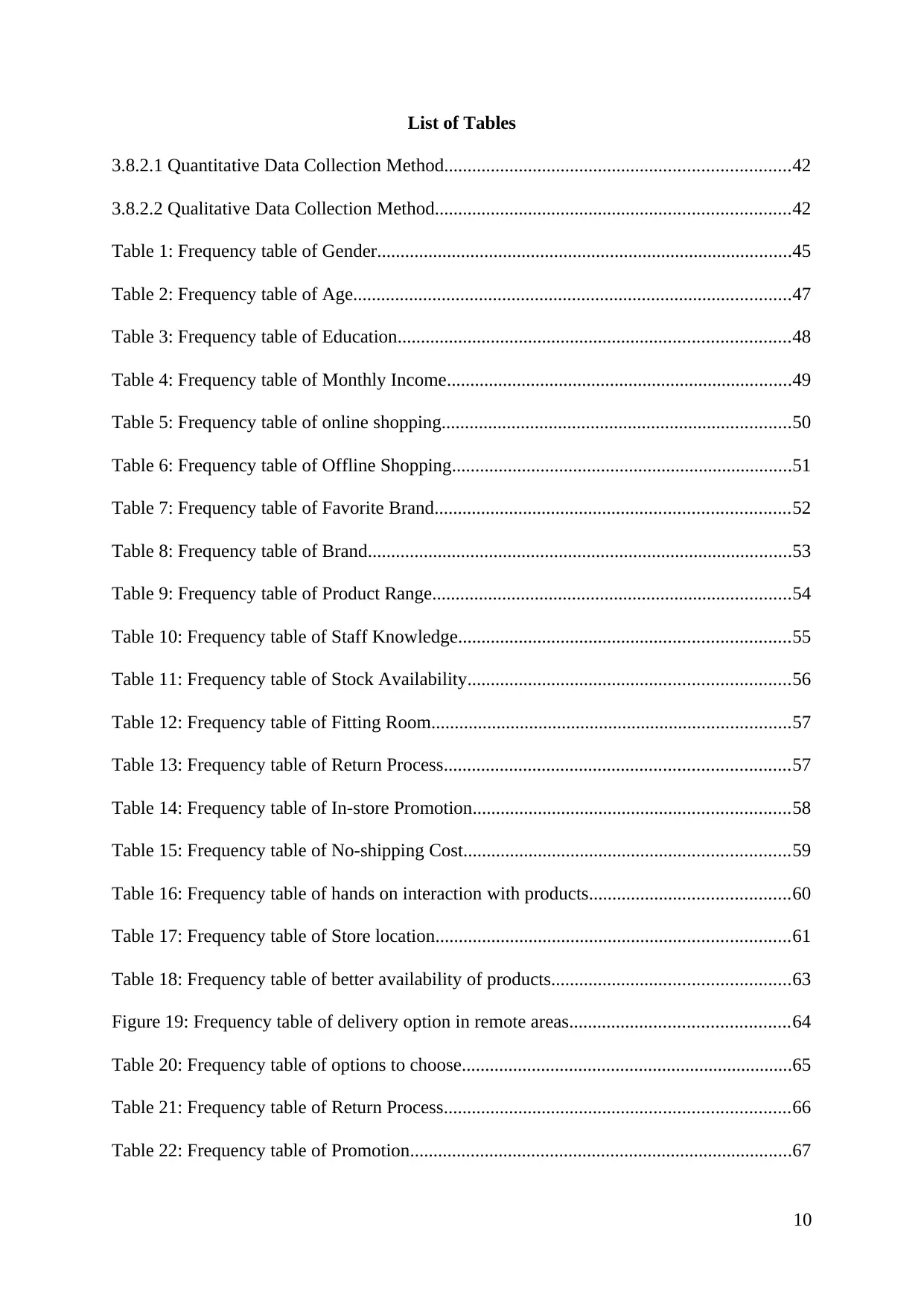
List of Tables
3.8.2.1 Quantitative Data Collection Method..........................................................................42
3.8.2.2 Qualitative Data Collection Method............................................................................42
Table 1: Frequency table of Gender.........................................................................................45
Table 2: Frequency table of Age..............................................................................................47
Table 3: Frequency table of Education....................................................................................48
Table 4: Frequency table of Monthly Income..........................................................................49
Table 5: Frequency table of online shopping...........................................................................50
Table 6: Frequency table of Offline Shopping.........................................................................51
Table 7: Frequency table of Favorite Brand............................................................................52
Table 8: Frequency table of Brand...........................................................................................53
Table 9: Frequency table of Product Range.............................................................................54
Table 10: Frequency table of Staff Knowledge.......................................................................55
Table 11: Frequency table of Stock Availability.....................................................................56
Table 12: Frequency table of Fitting Room.............................................................................57
Table 13: Frequency table of Return Process..........................................................................57
Table 14: Frequency table of In-store Promotion....................................................................58
Table 15: Frequency table of No-shipping Cost......................................................................59
Table 16: Frequency table of hands on interaction with products...........................................60
Table 17: Frequency table of Store location............................................................................61
Table 18: Frequency table of better availability of products...................................................63
Figure 19: Frequency table of delivery option in remote areas...............................................64
Table 20: Frequency table of options to choose.......................................................................65
Table 21: Frequency table of Return Process..........................................................................66
Table 22: Frequency table of Promotion..................................................................................67
10
3.8.2.1 Quantitative Data Collection Method..........................................................................42
3.8.2.2 Qualitative Data Collection Method............................................................................42
Table 1: Frequency table of Gender.........................................................................................45
Table 2: Frequency table of Age..............................................................................................47
Table 3: Frequency table of Education....................................................................................48
Table 4: Frequency table of Monthly Income..........................................................................49
Table 5: Frequency table of online shopping...........................................................................50
Table 6: Frequency table of Offline Shopping.........................................................................51
Table 7: Frequency table of Favorite Brand............................................................................52
Table 8: Frequency table of Brand...........................................................................................53
Table 9: Frequency table of Product Range.............................................................................54
Table 10: Frequency table of Staff Knowledge.......................................................................55
Table 11: Frequency table of Stock Availability.....................................................................56
Table 12: Frequency table of Fitting Room.............................................................................57
Table 13: Frequency table of Return Process..........................................................................57
Table 14: Frequency table of In-store Promotion....................................................................58
Table 15: Frequency table of No-shipping Cost......................................................................59
Table 16: Frequency table of hands on interaction with products...........................................60
Table 17: Frequency table of Store location............................................................................61
Table 18: Frequency table of better availability of products...................................................63
Figure 19: Frequency table of delivery option in remote areas...............................................64
Table 20: Frequency table of options to choose.......................................................................65
Table 21: Frequency table of Return Process..........................................................................66
Table 22: Frequency table of Promotion..................................................................................67
10
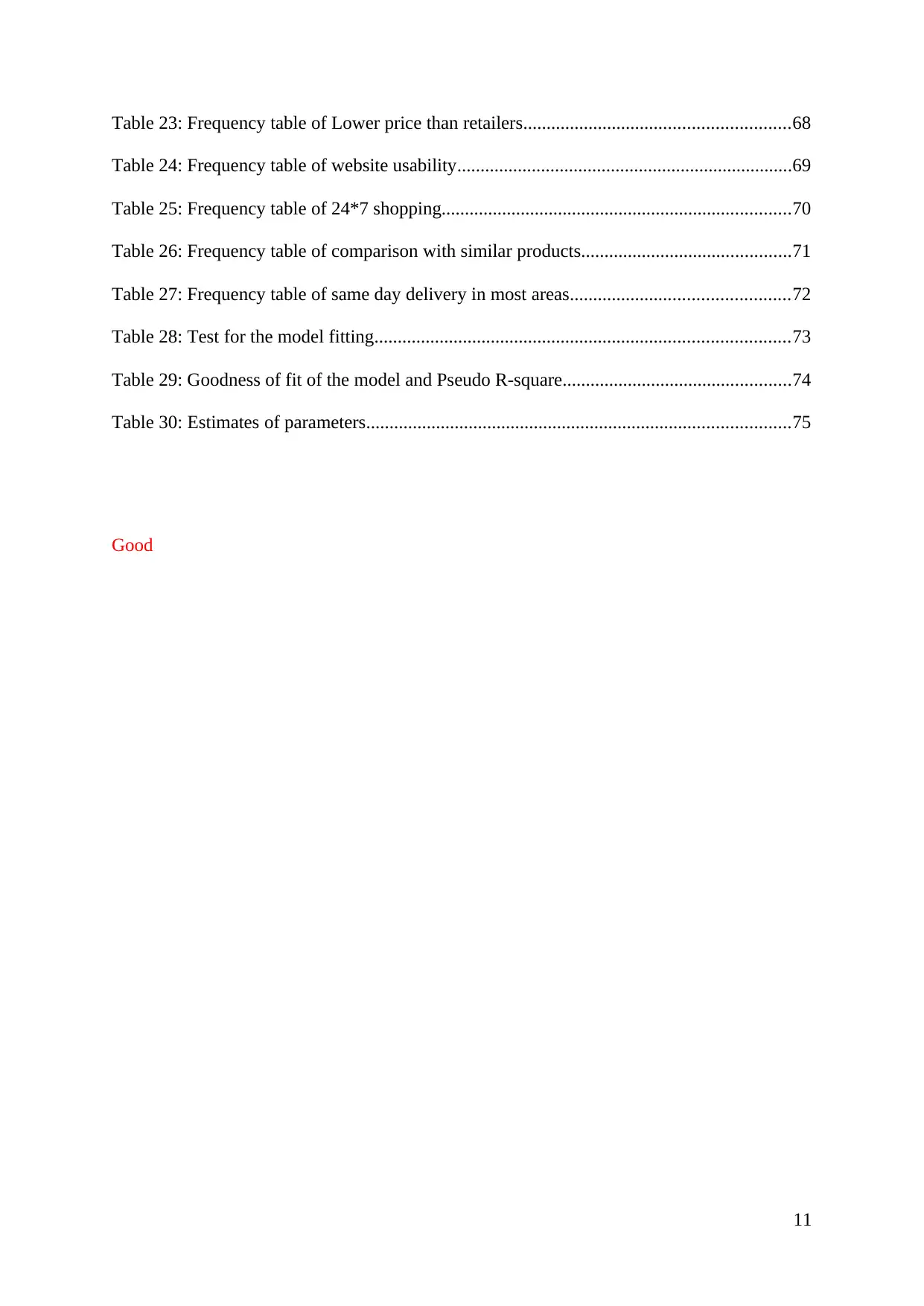
Table 23: Frequency table of Lower price than retailers.........................................................68
Table 24: Frequency table of website usability........................................................................69
Table 25: Frequency table of 24*7 shopping...........................................................................70
Table 26: Frequency table of comparison with similar products.............................................71
Table 27: Frequency table of same day delivery in most areas...............................................72
Table 28: Test for the model fitting.........................................................................................73
Table 29: Goodness of fit of the model and Pseudo R-square.................................................74
Table 30: Estimates of parameters...........................................................................................75
Good
11
Table 24: Frequency table of website usability........................................................................69
Table 25: Frequency table of 24*7 shopping...........................................................................70
Table 26: Frequency table of comparison with similar products.............................................71
Table 27: Frequency table of same day delivery in most areas...............................................72
Table 28: Test for the model fitting.........................................................................................73
Table 29: Goodness of fit of the model and Pseudo R-square.................................................74
Table 30: Estimates of parameters...........................................................................................75
Good
11
⊘ This is a preview!⊘
Do you want full access?
Subscribe today to unlock all pages.

Trusted by 1+ million students worldwide
1 out of 123
Related Documents
Your All-in-One AI-Powered Toolkit for Academic Success.
+13062052269
info@desklib.com
Available 24*7 on WhatsApp / Email
![[object Object]](/_next/static/media/star-bottom.7253800d.svg)
Unlock your academic potential
Copyright © 2020–2025 A2Z Services. All Rights Reserved. Developed and managed by ZUCOL.





